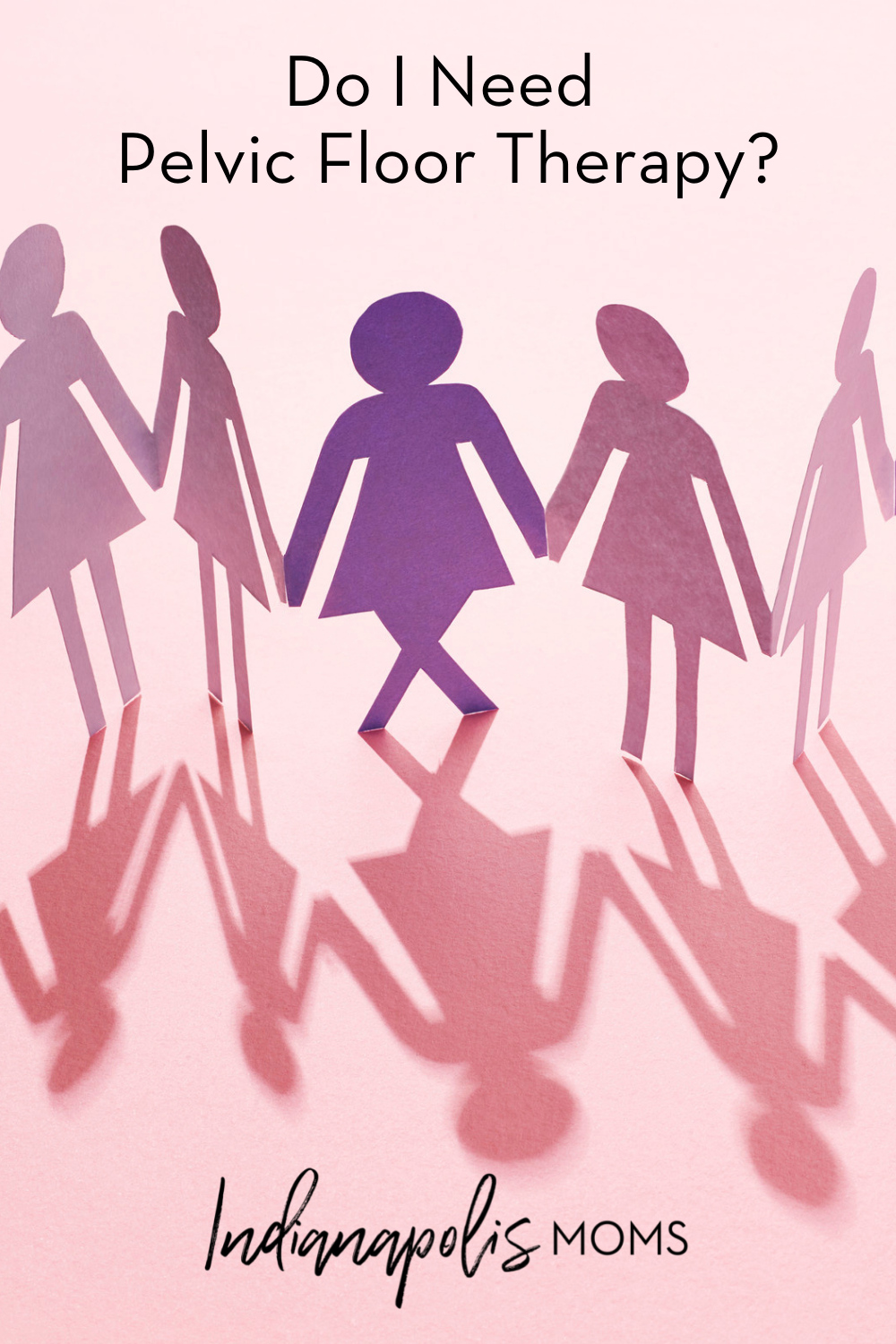As a mother to two young children, I often think back to when I brought my little bundles of joy home. My life shifted immediately when we walked in the door, making my little one a top priority. One thing I wish I had done differently is taking better care of myself during both of my postpartum periods, especially when it came to my pelvic health. We know there are a lot of women in the same boat, so we recently spoke with Kaylene Hernandez, a Board Certified Specialist in Women’s Health Physical Therapy at IU Health North Hospital. She is passionate about educating women about pelvic health, and she has answered our questions about pelvic floor therapy.
 What symptoms should I be looking for to determine if I need to see a pelvic floor therapist?
What symptoms should I be looking for to determine if I need to see a pelvic floor therapist?
The Pelvic Therapy Rehabilitation team at IU Health serves patients as young as pediatrics to patients during pregnancy, postpartum, and even through menopause. “There are a variety of symptoms that can lead a patient to seek care from a pelvic health therapist,” says Hernandez. She continues by saying the team’s most common ailments they treat are during and after pregnancy, and the symptoms include urinary incontinence, urinary urgency or frequency, constipation, fecal incontinence, dyspareunia (or painful sex), symptoms of pelvic organ prolapse, low back pain, hip pain, pelvic pain, sacroiliac pain, diastasis recti, perhaps scar pain after surgery, or concerns with returning to exercise.
“Some women also seek out pelvic health rehabilitation to assist in screenings, like a ‘return to run’ screening or return to exercise screening,” according to Hernandez. This is something a woman can do beyond the 6-week postpartum check-up with her gynecologist, to double-check that they are ready to return to physical activity. “Others use pelvic health rehabilitation to prepare for labor and delivery including finding successful laboring positions or assisting with perineal stretching to decrease the risk for perineal lacerations with vaginal deliveries.”
What can I expect during therapy appointments?
Pelvic rehabilitation is done in a private treatment room. You will first complete a pelvic health evaluation, which is typically an hour-long appointment, and you talk through your symptoms, your medical history, and your pelvic health goals with your provider. “Your provider wants to know as much about your pelvic health journey as possible to tailor the right treatment course to your needs.”
Next, you will have a physical examination. Hernandez explains that “the examination with a ‘whole body’ approach looks at the range of motion, strength, movement patterns and strategies, pelvic floor muscle strength and coordination, scar tissue, posture, and much more.”
After the evaluation and examination, the therapist will provide a rundown of the treatment plan, which is tailored to each woman and includes appointment frequency and duration of follow-up as well as interventions that will be involved. This treatment plan is a holistic approach that includes strategies and stretches to help your muscles as well as your posture. If needed, they also look at scars to see how they’re healing. Appointments are exercise-based and include “a lot of education about anatomy and how pelvic muscles are involved in their system,” according to Hernandez. Some sessions can be done virtually, but if hands-on exercises need to be completed, the appointment takes place in person.
What is the typical schedule for someone needing pelvic therapy? How long does therapy last?
An average schedule for pelvic therapy is between six and 12 sessions of physical therapy. “It depends on the severity and involvement as well as duration of symptoms and the patient’s goals,” according to Hernandez. If a patient’s symptoms are mild and acute, they may only need a handful of sessions. If the patient’s symptoms are severe and chronic in nature, they may need a longer duration of treatment.
C-section recovery—are there additional resources for women who need it (scar mobilization, for example)?
“Absolutely! I think it is a common practice for a patient to be ‘released’ to all activity six to eight weeks after delivery, even cesarean section. We have to remember that this was still major surgery,” says Hernandez. “People get referred to physical therapy after many other surgeries, like ACL reconstruction or a total knee replacement. Women after c-section need guidance with healing too.”
Hernandez continues by saying a lot of women are really nervous to touch or look at that scar after returning home, so they often shift their focus on anything else to care for their infant. But it’s important for those that had a c-section to understand when rehabilitation is needed to teach those core muscles to be utilized again. The team will still screen a pelvic floor even if a woman delivered their baby via c-section because their pelvic floor still carried the weight of a baby for the entirety of the pregnancy. Perhaps they even labored for a length of time. “Postpartum recovery doesn’t need to be a ‘DIY’ process. We focus on returning to mobility and scar care,” says Hernandez. “We assist them with core strengthening and returning to activities they love without pain.”
Do I need to see my family doctor or OB/GYN for a pelvic floor therapist referral?
Hernandez says, “In the state of Indiana, a patient has “Direct Access” to a physical therapist. This means they can see a physical therapist for 42 calendar days without a physicians’ referral.” A patient has direct access to physical therapy, meaning a physician’s referral is not required by most insurance plans for the evaluation and the first six (6) weeks of physical therapy support. Hernandez encourages patients to alert their primary care physician and/or OB/GYN to any challenges they’re experiencing that make them want to seek out physical therapy for improvement.
Are there things I can do at home to try and strengthen my pelvic floor after giving birth?
Kegels are number one, says Hernandez, and they are safe to start whenever you want after giving birth. The role of the pelvic floor is to support our organs, and strengthening those muscles can begin right away. Hernandez recommends doing Kegels with functional activities. “The best way to include them is throughout the day. Any activity that you feel an increased pressure in your abdomen, try performing that activity with a Kegel,” says Hernandez. “Lifting, getting out of bed, bending over, standing from a chair, coughing or sneezing.” Hernandez does warn that if a patient is experiencing pain or increased symptoms from performing these pelvic floor contractions, they should stop the exercise and seek assistance from a pelvic rehab therapist.
If I’ve waited 5+ years since my last birth, will pelvic floor PT still be beneficial? Have I missed my window?
No, you have not missed your window, and it’s never too late! “We serve individuals across the lifespan,” says Hernandez. “And we want to see you in the season you are in. More times than not, we are seeing women at several points in their life: pregnancy, postpartum, peri, and/or post-menopause. The exciting part about pelvic health rehabilitation is that a patient can benefit from it at any point in their lifespan.”
In today’s society, the notion that women can “bounce back” quickly after giving birth is often misleading and sends the message that pelvic floor weakness is normal. Hernandez is passionate about helping people improve their pelvic floor health. “We need to give ourselves grace and that’s the best form of self-care you can give yourself,” says Hernandez. And no matter what season of life you are in, the Pelvic Therapy Rehabilitation team at IU Health is here to support you.
 About Kaylene Hernandez, PT, DPT, WCS, CLT
About Kaylene Hernandez, PT, DPT, WCS, CLT
Kaylene Hernandez, a Board Certified Specialist in Women’s Health Physical Therapy, graduated from Duke University in 2014 with her Doctorate in Physical Therapy. Her clinical areas of specialty include male and female pelvic health, pregnancy and postpartum rehabilitation, complete decongestive therapy for the treatment of lymphedema, and breast cancer rehabilitation. She has received extensive training in pelvic health rehabilitation, including a specialization in pediatrics, from the Herman and Wallace Institute. Along with her impressive resume, she enjoys triathlons, navigating the journey of first time parenthood with her husband Cory, and traveling anywhere with sun and sand.
Indiana University Health
Named among the “Best Hospitals in America” by U.S. News & World Report for 22 consecutive years, Indiana University Health is dedicated to providing a unified standard of preeminent, patient-centered care. A unique partnership with Indiana University School of Medicine – one of the nation’s leading medical schools – gives our highly skilled physicians access to innovative treatments using the latest research and technology. Learn more at iuhealth.org.










